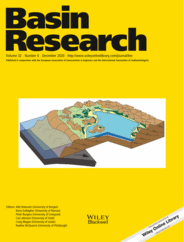
Full text loading...
 , Yunpeng Dong1,2
, Yunpeng Dong1,2
The western North China Craton (W‐NCC) comprises the Alxa Terrane in the west and the Ordos Block in the east; they are separated by the Helanshan Tectonic Belt (HTB). There is an extensive debate regarding the significant Ordovician tectonic setting of the W‐NCC. Most paleogeographic reconstructions emphasized the formation and rapid subsidence of an aulacogen along the HTB during the Middle–Late Ordovician, whereas paleomagnetic and geochronologic results suggested that the Alxa Terrane and the Ordos Block were independent blocks separated by the HTB. In this study, stratigraphic and geochronologic methods were used to constrain the Ordovician tectonic processes of the W‐NCC. Stratigraphic correlations show that the Early Ordovician strata comprise ~500‐m‐thick tidal flat and lagoon carbonate successions with a progressive eastward onlap, featuring a west‐deepening shallow‐water carbonate shelf. In contrast, the Late Ordovician strata are composed of ~3,000‐m‐thick abyssal turbidites in the west and ~400‐m‐thick shallow‐water carbonates in the east, defining an eastward‐tapering basin architecture. Early Ordovician detrital zircons with ages of ~2,800–1,700 Ma were derived from the Ordos Block; the Late Ordovician turbidites were sourced from the western Alxa Terrane, based on zircon ages clustered at ~1,000–900 Ma. The petrographic modal composition and zircon age distribution imply a provenance shift from a stable craton to a recycled orogen in the Middle Ordovician. These shifts define a tectonic conversion from a passive continental margin to a foreland basin at ~467 Ma, resulting in the eastward progradation of the turbidite wedge around the HTB, the eastward backstepping of the carbonate platform in the east and the eastward expansion of orogenic thrusting in the western Alxa Terrane. This tectono‐sedimentary shift coincided with the advancing subduction of the southern Paleo‐Asian Ocean beneath the Alxa Terrane, generating the western Alxa continental arc and the paired retro‐arc foredeep in the east under a compressional tectonic regime.
,Reconstruction model of the Ordovician tectono‐sedimentology evolution of the Northwestern Ordos Terrane.

Article metrics loading...

Full text loading...
References


Data & Media loading...

